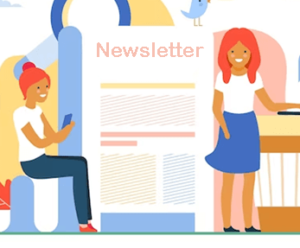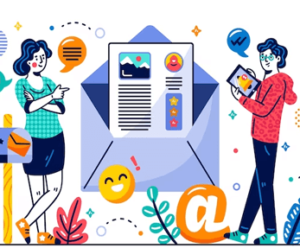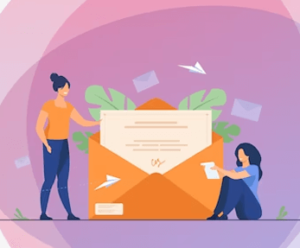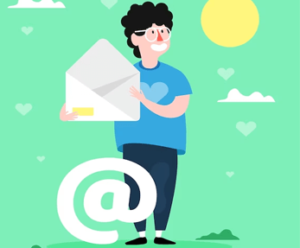What's Inside?
A newsletter is a regularly distributed publication containing news, information, and updates about a particular topic, industry, organization, or community. Newsletters can be distributed through email, physical mail, or online platforms. They typically include articles, feature stories, announcements, and other content related to the topic or industry they cover. Newsletters can serve a variety of purposes, such as keeping customers informed about company updates, providing educational content to subscribers, or promoting products and services. They can also be used to build relationships with customers or members of a community by providing valuable and engaging content that keeps them informed and interested.
What should be in a newsletter?
The content of a newsletter may vary depending on the purpose and audience of the newsletter, but generally, a newsletter should include the following elements:
- Header: A header or banner at the top of the newsletter that includes the name of the newsletter, logo, and a visually appealing design.
- Introduction: A brief introduction or welcome message that sets the tone and purpose of the newsletter.
- Feature Content: The main body of the newsletter should contain feature articles, news, or updates that are relevant and interesting to the target audience. This content should be organized and easy to read, with headings and subheadings to break up the text.
- Images and Graphics: Including high-quality images, photos, or graphics can add visual appeal and make the newsletter more engaging.
- Call to Action: A call to action (CTA) encourages readers to take a specific action, such as visiting a website, signing up for a service, or registering for an event.
- Social Media Links: Including links to social media pages or accounts can help readers connect with the organization or business and stay up-to-date on news and updates.
- Contact Information: Including contact information such as a phone number, email address, or physical address can make it easy for readers to reach out and connect with the organization.
- Footer: A footer at the bottom of the newsletter may include additional information such as legal disclaimers, copyright information, or links to privacy policies.
It’s important to keep the content of your newsletter relevant and valuable to your audience, and to maintain a consistent tone and format. Additionally, newsletters should be sent at regular intervals, whether that’s weekly, monthly, or quarterly, to keep readers engaged and interested.
How long should a newsletter be?
 The ideal length of a newsletter depends on the content and the audience, but in general, newsletters should be concise and to the point. Most readers have a limited attention span and may not have the time to read through a lengthy newsletter.
The ideal length of a newsletter depends on the content and the audience, but in general, newsletters should be concise and to the point. Most readers have a limited attention span and may not have the time to read through a lengthy newsletter.
As a general rule of thumb, it’s best to keep your newsletter between 500 and 1500 words. This is long enough to provide valuable content and information but short enough to keep readers engaged and interested. If you have a lot of information to share, consider breaking it up into shorter sections or creating a series of newsletters.
It’s also a good idea to use subheadings, bullet points, and images to break up the text and make the newsletter easier to read. Additionally, you may want to consider providing a brief summary or teaser for each article or section, so readers can quickly decide which content they want to read in more detail.
The length of your newsletter should be based on your audience’s preferences and your goals for the newsletter. Keep in mind that the content should always be high-quality, valuable, and relevant to your readers.
Importance of Newsletter
Newsletters can be an important tool for businesses, organizations, and individuals to communicate with their audience and achieve various goals. Here are some of the key benefits of newsletters:
- Build relationships: Newsletters can help build relationships with your audience by providing valuable and relevant content that keeps them engaged and informed.
- Drive traffic: Including links to your website, blog, or social media pages can help drive traffic and increase visibility for your brand or business.
- Promote products or services: Newsletters can be a great way to promote new products, services, or offers to your audience.
- Establish expertise: Providing educational or informative content can help establish your expertise in your field and build trust with your audience.
- Increase engagement: Newsletters can encourage engagement from your audience through calls to action, surveys, or feedback forms.
- Increase brand awareness: Consistently sending newsletters can increase brand awareness and help keep your business or organization top of mind with your audience.
- Cost-effective: Compared to other marketing tactics, newsletters can be a cost-effective way to reach your audience and achieve your goals.
Newsletters can be an effective tool for building relationships, driving traffic, and achieving various marketing and communication goals.
How to Create a Newsletter
Here are the general steps for creating a newsletter:
- Define your goals: Start by defining the purpose and goals of your newsletter. Consider who your audience is, what type of content you want to include, and what action you want readers to take.
- Choose a platform: There are various platforms and tools you can use to create and distribute newsletters, including email marketing software like Mailchimp or Constant Contact, or a content management system like WordPress.
- Design your newsletter: Choose a layout and design that reflects your brand or organization and makes your content easy to read and engaging. Use visuals like images, infographics, and videos to break up the text and make your newsletter more visually appealing.
- Create content: Develop content that is valuable and relevant to your audience, such as articles, news updates, or special offers. Make sure your content is well-written, concise, and informative.
- Add calls to action: Include calls to action in your newsletter, such as links to your website, social media pages, or product pages. Encourage readers to take a specific action, such as signing up for a service or registering for an event.
- Test and preview: Preview your newsletter and test it on different devices and email clients to ensure that it looks and functions as intended.
- Send your newsletter: Choose a date and time to send your newsletter, and use your email marketing software to distribute it to your subscribers. Be sure to analyze the results of your newsletter and make adjustments as needed to improve engagement and reach your goals.
Creating a newsletter takes time and effort, but can be a valuable tool for building relationships, driving traffic, and achieving your marketing and communication goals.
What is the Purpose of a Newsletter?
 The purpose of a newsletter is to provide information and updates to a specific audience on a regular basis. Newsletters can serve various purposes depending on the organization or individual creating them, but here are some of the common goals:
The purpose of a newsletter is to provide information and updates to a specific audience on a regular basis. Newsletters can serve various purposes depending on the organization or individual creating them, but here are some of the common goals:
- Build relationships: Newsletters can help build and maintain relationships with an audience by providing regular communication and valuable content that keeps them engaged and informed.
- Increase engagement: Newsletters can encourage engagement from the audience through calls to action, feedback forms, surveys, or social media links.
- Drive traffic: Newsletters can include links to websites, blogs, or social media pages to increase traffic and visibility for a brand or organization.
- Promote products or services: Newsletters can be a useful tool to promote new products, services, or offers to an audience.
- Establish expertise: Newsletters can help establish an organization or individual’s expertise in their field and build trust with the audience by providing educational or informative content.
- Increase brand awareness: Consistently sending newsletters can increase brand awareness and help keep a brand or organization top of mind with the audience.
Newsletters can serve various purposes and can be an effective tool for communicating with an audience and achieving marketing and communication goals.
How email newsletters can help you promote your brand
Email newsletters can be a powerful tool for promoting your brand and increasing visibility among your target audience. Here are some ways in which email newsletters can help you promote your brand:
- Increase brand awareness: By regularly sending email newsletters to your subscribers, you can increase awareness of your brand and keep it top of mind with your audience.
- Promote products and services: Email newsletters are an effective way to promote new products, services, or special offers to your subscribers, which can help increase sales and revenue.
- Establish expertise: By providing educational or informative content in your newsletters, you can establish your expertise in your field and build trust with your audience.
- Drive traffic to your website: Including links to your website or specific landing pages in your newsletter can drive traffic to your site, which can help increase visibility and engagement.
- Engage with your audience: Email newsletters can be used to engage with your audience through feedback forms, surveys, or calls to action, which can help build relationships and increase loyalty.
- Segment your audience: By segmenting your audience and sending targeted newsletters to specific groups based on their interests or behavior, you can increase the relevance and effectiveness of your newsletters.
Email newsletters can be a cost-effective and powerful tool for promoting your brand and achieving your marketing goals. By consistently delivering valuable content to your subscribers, you can build relationships, increase engagement, and drive results for your brand.
What is an Email Newsletter?
An email newsletter is a regularly scheduled email that is sent to a group of subscribers who have opted in to receive updates, information, or promotions from a brand, organization, or individual. Email newsletters typically contain a combination of text, images, and links to website content, blog posts, or other resources.
Email newsletters can serve various purposes, such as promoting products or services, sharing news or updates, providing educational content, or building relationships with subscribers. They are typically sent on a regular basis, such as weekly, biweekly, or monthly, and are designed to keep subscribers engaged and informed.
Email newsletters can be created using email marketing software or a content management system, and typically include features like personalized greetings, unsubscribe links, and tracking analytics to measure the success of the newsletter.
Email newsletters can be a valuable tool for building relationships with subscribers, promoting products or services, and achieving marketing and communication goals. They offer a cost-effective and efficient way to reach a targeted audience and can help brands and organizations stay top of mind with their subscribers.
How to Create an Email Newsletter
 Here are the general steps for creating an email newsletter:
Here are the general steps for creating an email newsletter:
- Determine your newsletter goals: Before creating your newsletter, it’s important to identify your goals and what you want to achieve with it. This will help you to determine the content, layout, and design of your newsletter.
- Choose an email marketing platform: There are many email marketing platforms available that can help you create and send your newsletter, such as Mailchimp, Constant Contact, or Campaign Monitor.
- Define your target audience: Determine who your target audience is and segment your email list accordingly. This will help you to create more personalized and relevant newsletters that are tailored to the interests of your subscribers.
- Choose a newsletter template: Most email marketing platforms offer a variety of pre-designed newsletter templates that you can customize with your own branding, content, and images.
- Create content: Plan out the content of your newsletter and create engaging, informative, and visually appealing content that is relevant to your audience.
- Design your newsletter: Use your chosen newsletter template and customize it with your own branding, colors, images, and content.
- Test your newsletter: Before sending your newsletter, make sure to test it on different devices and email clients to ensure that it displays correctly.
- Send your newsletter: Once you’ve tested your newsletter and are satisfied with the design and content, it’s time to send it to your subscribers.
- Analyze the results: Use the analytics provided by your email marketing platform to track the success of your newsletter and make adjustments for future newsletters based on the data.
By following these steps, you can create an effective email newsletter that engages your subscribers and achieves your communication and marketing goals.
How To Build Your Email Newsletter Strategy
Building an effective email newsletter strategy involves the following steps:
- Define your goals: Start by defining your newsletter goals, such as increasing engagement, building brand awareness, or driving sales. This will help you to create content and design your newsletter accordingly.
- Identify your target audience: Determine who your target audience is and what their interests and needs are. This will help you to create more relevant and engaging content that resonates with your audience.
- Choose the right email marketing platform: Choose an email marketing platform that fits your needs and budget, and offers features such as list segmentation, personalization, and analytics.
- Build your email list: Create a process for building your email list, such as offering a lead magnet or incentive for signing up, or collecting email addresses at events or on your website.
- Develop a content strategy: Plan out the content for your newsletter and create a content calendar. This can include a mix of educational or informative content, promotional content, and curated content.
- Design your newsletter: Use a template or create a custom design for your newsletter that reflects your brand and engages your audience.
- Test and optimize: Test different elements of your newsletter, such as subject lines, content, and calls to action, and use analytics to optimize your strategy based on what works best for your audience.
- Monitor your results: Track your newsletter performance, such as open rates, click-through rates, and conversions, and use this data to make informed decisions about future newsletters.
By following these steps, you can develop a comprehensive email newsletter strategy that effectively engages your audience and achieves your marketing goals.
How To Create A High-Quality Email Newsletter
To create a high-quality email newsletter, follow these best practices:
- Choose a clear and concise subject line: Your subject line should be attention-grabbing and clearly communicate the content of your newsletter.
- Use a mobile-responsive design: Most people check their email on their mobile devices, so make sure your newsletter is optimized for mobile screens.
- Keep your design consistent with your brand: Use your brand colors, fonts, and imagery to create a consistent look and feel across all your marketing materials.
- Make it scannable: Use headings, subheadings, bullet points, and images to make your content easy to read and digest.
- Provide valuable content: Offer valuable and relevant content that is useful to your readers, such as educational resources, industry news, or exclusive offers.
- Include a clear call to action: Encourage your readers to take action by including clear and compelling calls to action, such as “Learn More” or “Shop Now”.
- Personalize your content: Use segmentation and personalization to deliver content that is tailored to your readers’ interests and needs.
- Make it easy to unsubscribe: Include an easy-to-find unsubscribe link in your newsletter to avoid spam complaints and maintain a clean email list.
- Test and optimize: Test different elements of your newsletter, such as subject lines, content, and calls to action, and use analytics to optimize your strategy based on what works best for your audience.
By following these best practices, you can create a high-quality email newsletter that engages your subscribers and achieves your communication and marketing goals.
What Is a Good Average Open Rate for Email Newsletters?
 The average open rate for email newsletters varies by industry and audience, but a good average open rate is generally considered to be between 20% and 30%. However, some industries, such as retail or media, may have higher open rates, while others, such as finance or legal, may have lower open rates.
The average open rate for email newsletters varies by industry and audience, but a good average open rate is generally considered to be between 20% and 30%. However, some industries, such as retail or media, may have higher open rates, while others, such as finance or legal, may have lower open rates.
It’s important to note that open rates are affected by several factors, such as the quality of your email list, the relevance and quality of your content, and the frequency of your newsletters. Therefore, it’s important to regularly monitor and analyze your open rates, as well as other metrics such as click-through rates and conversions, to optimize your newsletter strategy and improve engagement with your subscribers.
How to Measure the Success of your Email Newsletter
To measure the success of your email newsletter, you can track and analyze the following metrics:
- Open rates: The percentage of subscribers who opened your email.
- Click-through rates (CTR): The percentage of subscribers who clicked on a link in your email.
- Conversion rates: The percentage of subscribers who completed a desired action, such as making a purchase or filling out a form.
- Bounce rates: The percentage of emails that were undeliverable and returned to the sender.
- Unsubscribe rates: The percentage of subscribers who opted out of receiving your emails.
- Forwarding rates: The percentage of subscribers who shared your email with others.
- Revenue generated: The amount of revenue generated from your email campaigns.
By regularly tracking and analyzing these metrics, you can gain insights into the effectiveness of your email newsletter strategy, identify areas for improvement, and make data-driven decisions to optimize your campaigns and improve engagement with your subscribers.
Newsletter FAQs
- Build and maintain relationships with their audience: Email newsletters can help businesses to keep in touch with their subscribers, share updates and news, and stay top-of-mind.
- Drive traffic to their website or other marketing channels: By including links to their website, social media profiles, or other marketing channels, businesses can use email newsletters to drive traffic and increase visibility.
- Nurture leads and convert them into customers: Email newsletters can be used to deliver personalized and relevant content to leads, educate them about the benefits of a product or service, and encourage them to take action.
- Increase customer retention and loyalty: By providing exclusive content, discounts, or rewards to their subscribers, businesses can use email newsletters to strengthen their relationships with their customers and increase loyalty.
- Gather feedback and insights: Email newsletters can be used to collect feedback and insights from subscribers through surveys, polls, or feedback forms.
- Build and maintain relationships with their audience: By delivering valuable and relevant content to subscribers on a regular basis, businesses can establish trust, credibility, and loyalty with their audience.
- Increase visibility and traffic: A newsletter can be used to promote content from a website or blog, driving traffic and increasing visibility.
- Nurture leads and convert them into customers: By delivering targeted content to subscribers based on their interests and behavior, businesses can nurture leads and encourage them to take action, such as making a purchase or signing up for a service.
- Showcase expertise and thought leadership: A newsletter can be used to showcase a business's expertise and thought leadership in a particular industry or niche, establishing the business as a trusted source of information and insights.
- Gather feedback and insights: A newsletter can be used to gather feedback and insights from subscribers, helping businesses to improve their content and better understand their audience's needs and preferences.
- Clear and concise subject line: The subject line is the first thing that subscribers see when they receive your newsletter, so it should be clear, concise, and engaging. A good subject line can entice subscribers to open and read your newsletter.
- Relevant and valuable content: Your newsletter should deliver content that is relevant, valuable, and engaging to your subscribers. This can include news, educational resources, promotions, or industry insights. The content should be tailored to your audience's interests and needs.
- Mobile-friendly design: With the majority of emails now opened on mobile devices, it's essential to ensure that your newsletter is mobile-friendly and optimized for different screen sizes.
- Consistent branding: Your newsletter should be consistent with your brand's identity, including colors, fonts, and imagery. This can help to strengthen brand recognition and loyalty.
- Call-to-action: Your newsletter should include clear calls-to-action that encourage subscribers to take action, such as visiting your website, signing up for a service, or making a purchase.
- Personalization: Personalizing your newsletter with subscribers' names or other relevant information can help to increase engagement and make them feel valued.
- Regular and consistent sending schedule: Your newsletter should be sent on a regular and consistent schedule, such as weekly or monthly, to keep your audience engaged and build a sense of expectation.


